Market Analysis of Coca-Cola: Marketing Principles, Failure & Strategy
VerifiedAdded on 2023/06/05
|8
|1519
|98
Report
AI Summary
This report delves into the marketing principles employed by Coca-Cola, examining both successful strategies and notable failures. It analyzes the reasons behind the failure of Coca-Cola C2, attributing it to inadequate market research and a lack of differentiation from existing products like Coke and Diet Coke. The report also identifies and categorizes Coca-Cola's competitors into direct, indirect, and phantom competitors, providing examples such as Pepsi and 7UP as direct competitors, Gatorade and Brisk tea as indirect competitors, and Lay's and Maggi as phantom competitors. The analysis incorporates macro and micro environmental factors impacting Coca-Cola's business, including economic conditions, social trends, and the bargaining power of suppliers. The report concludes by highlighting the importance of thorough market analysis in preventing costly product failures and maintaining a competitive edge. Desklib offers a wide range of similar solved assignments and past papers for students.
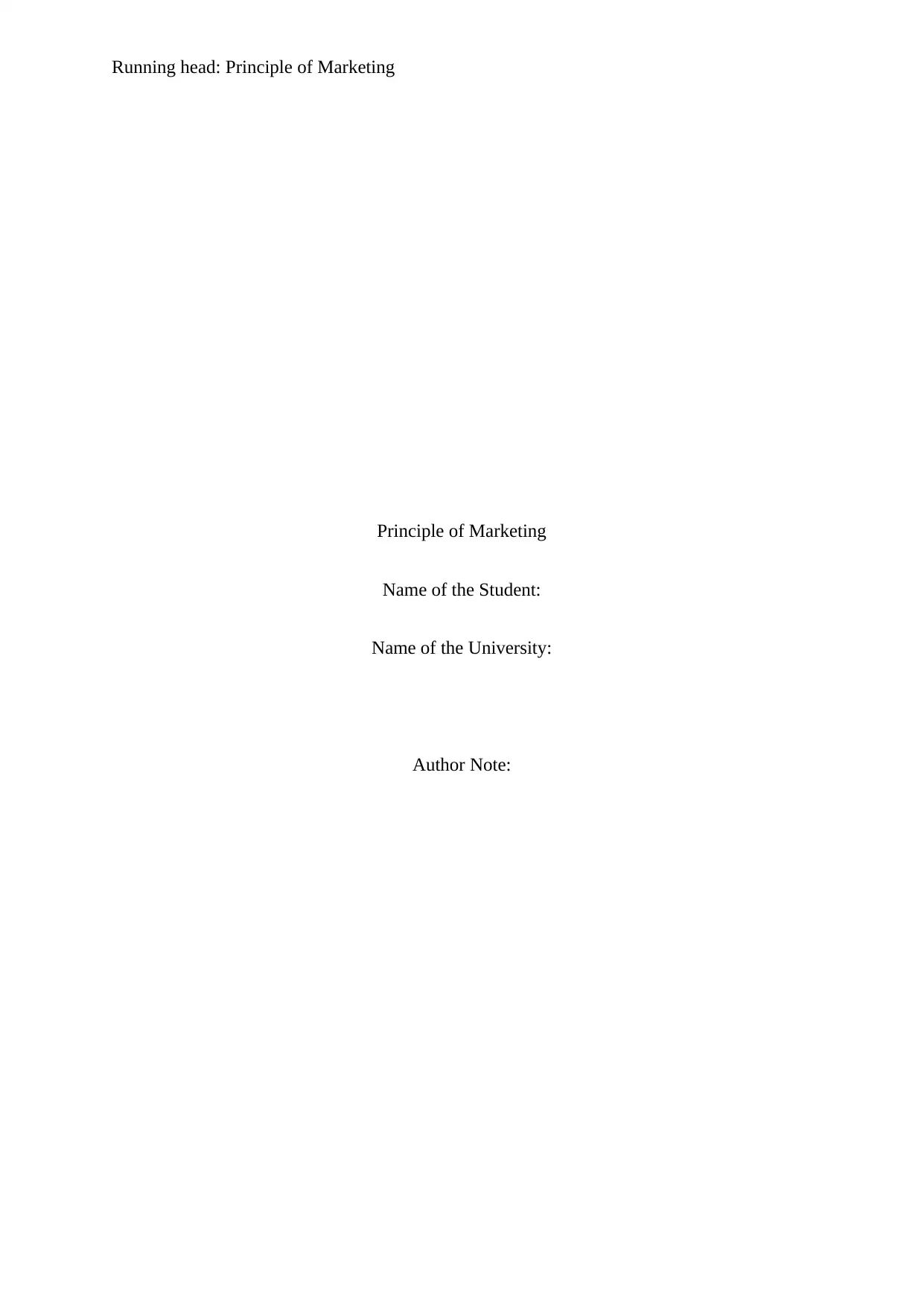
Running head: Principle of Marketing
Principle of Marketing
Name of the Student:
Name of the University:
Author Note:
Principle of Marketing
Name of the Student:
Name of the University:
Author Note:
Paraphrase This Document
Need a fresh take? Get an instant paraphrase of this document with our AI Paraphraser
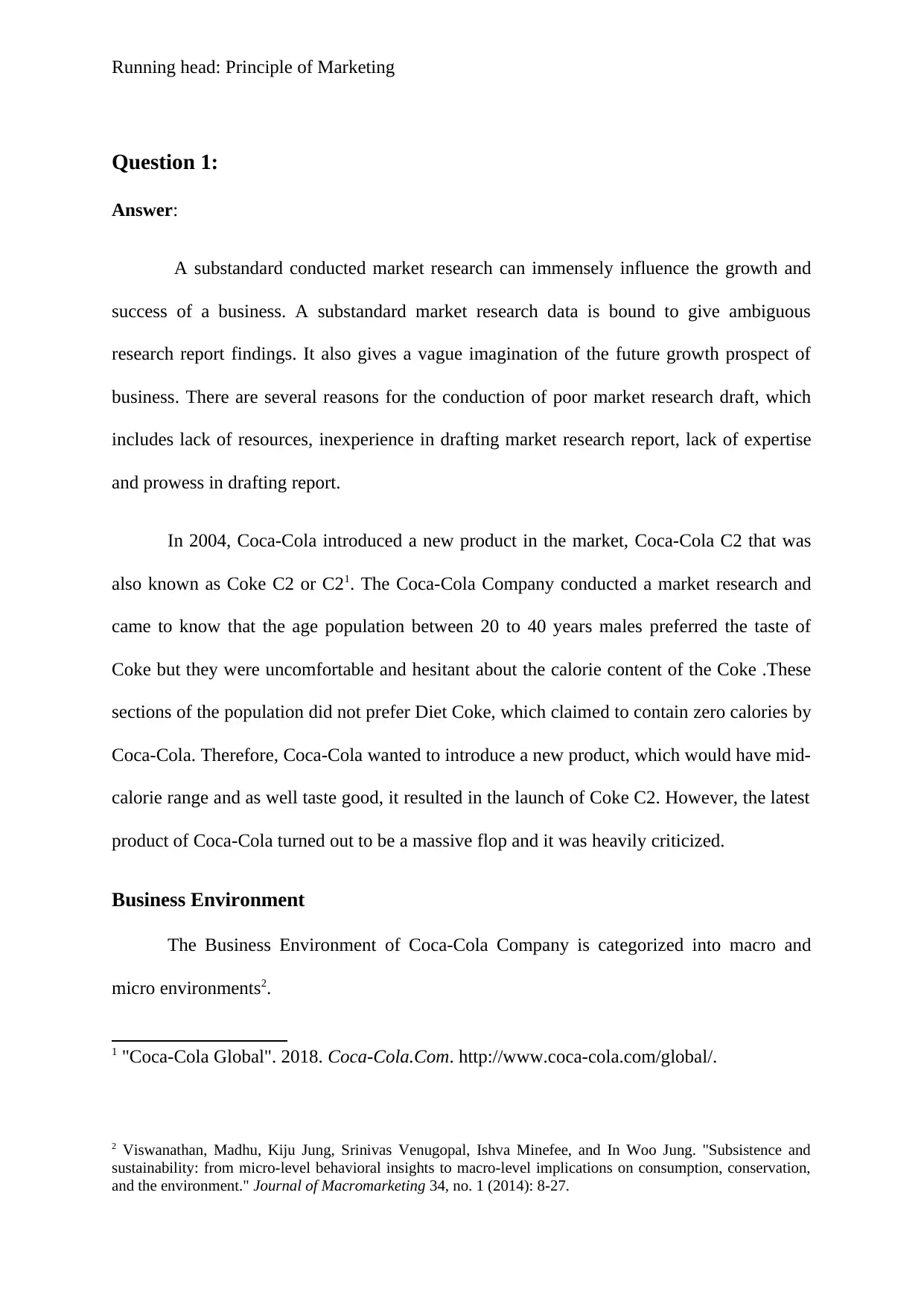
Running head: Principle of Marketing
Question 1:
Answer:
A substandard conducted market research can immensely influence the growth and
success of a business. A substandard market research data is bound to give ambiguous
research report findings. It also gives a vague imagination of the future growth prospect of
business. There are several reasons for the conduction of poor market research draft, which
includes lack of resources, inexperience in drafting market research report, lack of expertise
and prowess in drafting report.
In 2004, Coca-Cola introduced a new product in the market, Coca-Cola C2 that was
also known as Coke C2 or C21. The Coca-Cola Company conducted a market research and
came to know that the age population between 20 to 40 years males preferred the taste of
Coke but they were uncomfortable and hesitant about the calorie content of the Coke .These
sections of the population did not prefer Diet Coke, which claimed to contain zero calories by
Coca-Cola. Therefore, Coca-Cola wanted to introduce a new product, which would have mid-
calorie range and as well taste good, it resulted in the launch of Coke C2. However, the latest
product of Coca-Cola turned out to be a massive flop and it was heavily criticized.
Business Environment
The Business Environment of Coca-Cola Company is categorized into macro and
micro environments2.
1 "Coca-Cola Global". 2018. Coca-Cola.Com. http://www.coca-cola.com/global/.
2 Viswanathan, Madhu, Kiju Jung, Srinivas Venugopal, Ishva Minefee, and In Woo Jung. "Subsistence and
sustainability: from micro-level behavioral insights to macro-level implications on consumption, conservation,
and the environment." Journal of Macromarketing 34, no. 1 (2014): 8-27.
Question 1:
Answer:
A substandard conducted market research can immensely influence the growth and
success of a business. A substandard market research data is bound to give ambiguous
research report findings. It also gives a vague imagination of the future growth prospect of
business. There are several reasons for the conduction of poor market research draft, which
includes lack of resources, inexperience in drafting market research report, lack of expertise
and prowess in drafting report.
In 2004, Coca-Cola introduced a new product in the market, Coca-Cola C2 that was
also known as Coke C2 or C21. The Coca-Cola Company conducted a market research and
came to know that the age population between 20 to 40 years males preferred the taste of
Coke but they were uncomfortable and hesitant about the calorie content of the Coke .These
sections of the population did not prefer Diet Coke, which claimed to contain zero calories by
Coca-Cola. Therefore, Coca-Cola wanted to introduce a new product, which would have mid-
calorie range and as well taste good, it resulted in the launch of Coke C2. However, the latest
product of Coca-Cola turned out to be a massive flop and it was heavily criticized.
Business Environment
The Business Environment of Coca-Cola Company is categorized into macro and
micro environments2.
1 "Coca-Cola Global". 2018. Coca-Cola.Com. http://www.coca-cola.com/global/.
2 Viswanathan, Madhu, Kiju Jung, Srinivas Venugopal, Ishva Minefee, and In Woo Jung. "Subsistence and
sustainability: from micro-level behavioral insights to macro-level implications on consumption, conservation,
and the environment." Journal of Macromarketing 34, no. 1 (2014): 8-27.
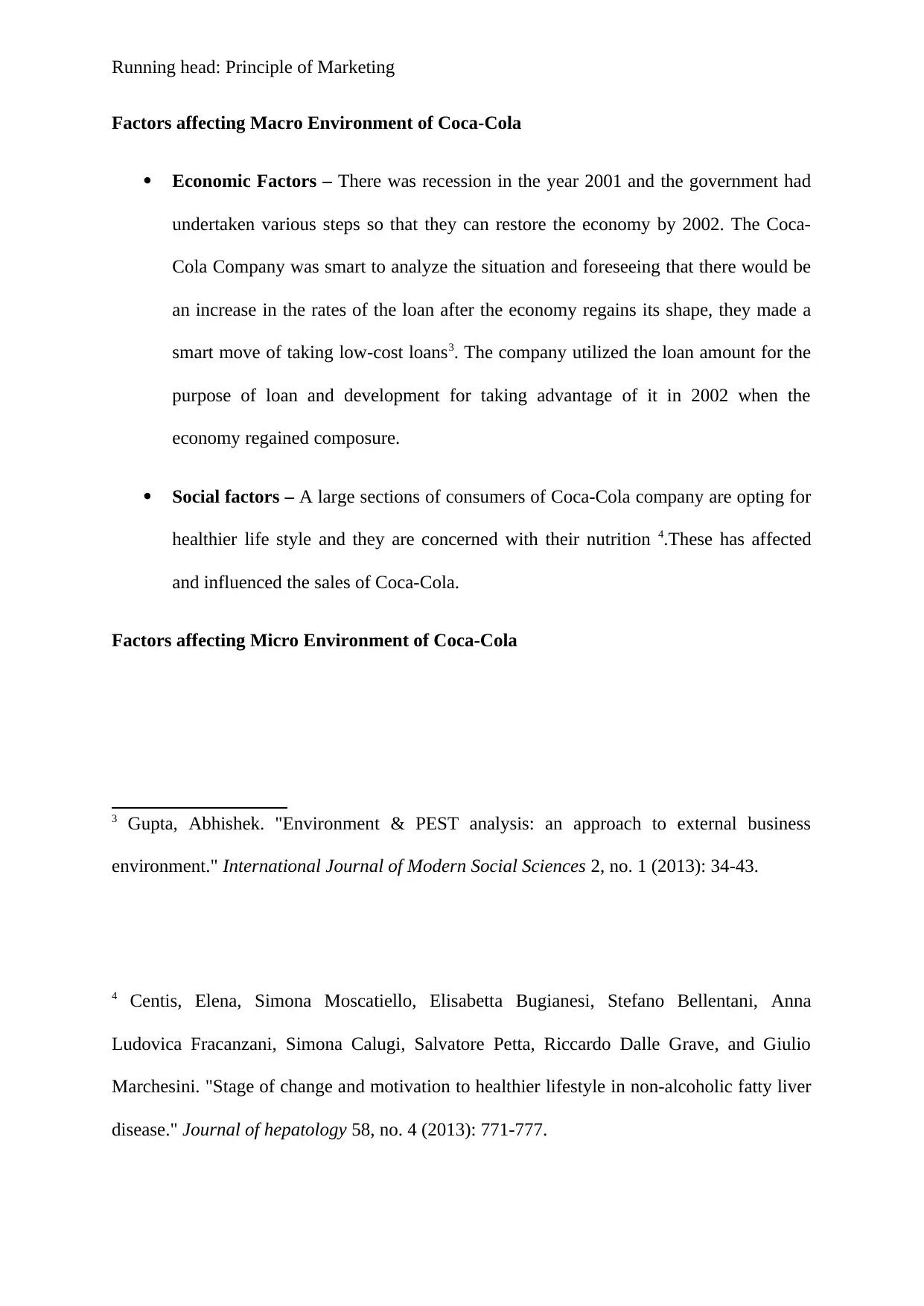
Running head: Principle of Marketing
Factors affecting Macro Environment of Coca-Cola
Economic Factors – There was recession in the year 2001 and the government had
undertaken various steps so that they can restore the economy by 2002. The Coca-
Cola Company was smart to analyze the situation and foreseeing that there would be
an increase in the rates of the loan after the economy regains its shape, they made a
smart move of taking low-cost loans3. The company utilized the loan amount for the
purpose of loan and development for taking advantage of it in 2002 when the
economy regained composure.
Social factors – A large sections of consumers of Coca-Cola company are opting for
healthier life style and they are concerned with their nutrition 4.These has affected
and influenced the sales of Coca-Cola.
Factors affecting Micro Environment of Coca-Cola
3 Gupta, Abhishek. "Environment & PEST analysis: an approach to external business
environment." International Journal of Modern Social Sciences 2, no. 1 (2013): 34-43.
4 Centis, Elena, Simona Moscatiello, Elisabetta Bugianesi, Stefano Bellentani, Anna
Ludovica Fracanzani, Simona Calugi, Salvatore Petta, Riccardo Dalle Grave, and Giulio
Marchesini. "Stage of change and motivation to healthier lifestyle in non-alcoholic fatty liver
disease." Journal of hepatology 58, no. 4 (2013): 771-777.
Factors affecting Macro Environment of Coca-Cola
Economic Factors – There was recession in the year 2001 and the government had
undertaken various steps so that they can restore the economy by 2002. The Coca-
Cola Company was smart to analyze the situation and foreseeing that there would be
an increase in the rates of the loan after the economy regains its shape, they made a
smart move of taking low-cost loans3. The company utilized the loan amount for the
purpose of loan and development for taking advantage of it in 2002 when the
economy regained composure.
Social factors – A large sections of consumers of Coca-Cola company are opting for
healthier life style and they are concerned with their nutrition 4.These has affected
and influenced the sales of Coca-Cola.
Factors affecting Micro Environment of Coca-Cola
3 Gupta, Abhishek. "Environment & PEST analysis: an approach to external business
environment." International Journal of Modern Social Sciences 2, no. 1 (2013): 34-43.
4 Centis, Elena, Simona Moscatiello, Elisabetta Bugianesi, Stefano Bellentani, Anna
Ludovica Fracanzani, Simona Calugi, Salvatore Petta, Riccardo Dalle Grave, and Giulio
Marchesini. "Stage of change and motivation to healthier lifestyle in non-alcoholic fatty liver
disease." Journal of hepatology 58, no. 4 (2013): 771-777.
⊘ This is a preview!⊘
Do you want full access?
Subscribe today to unlock all pages.

Trusted by 1+ million students worldwide
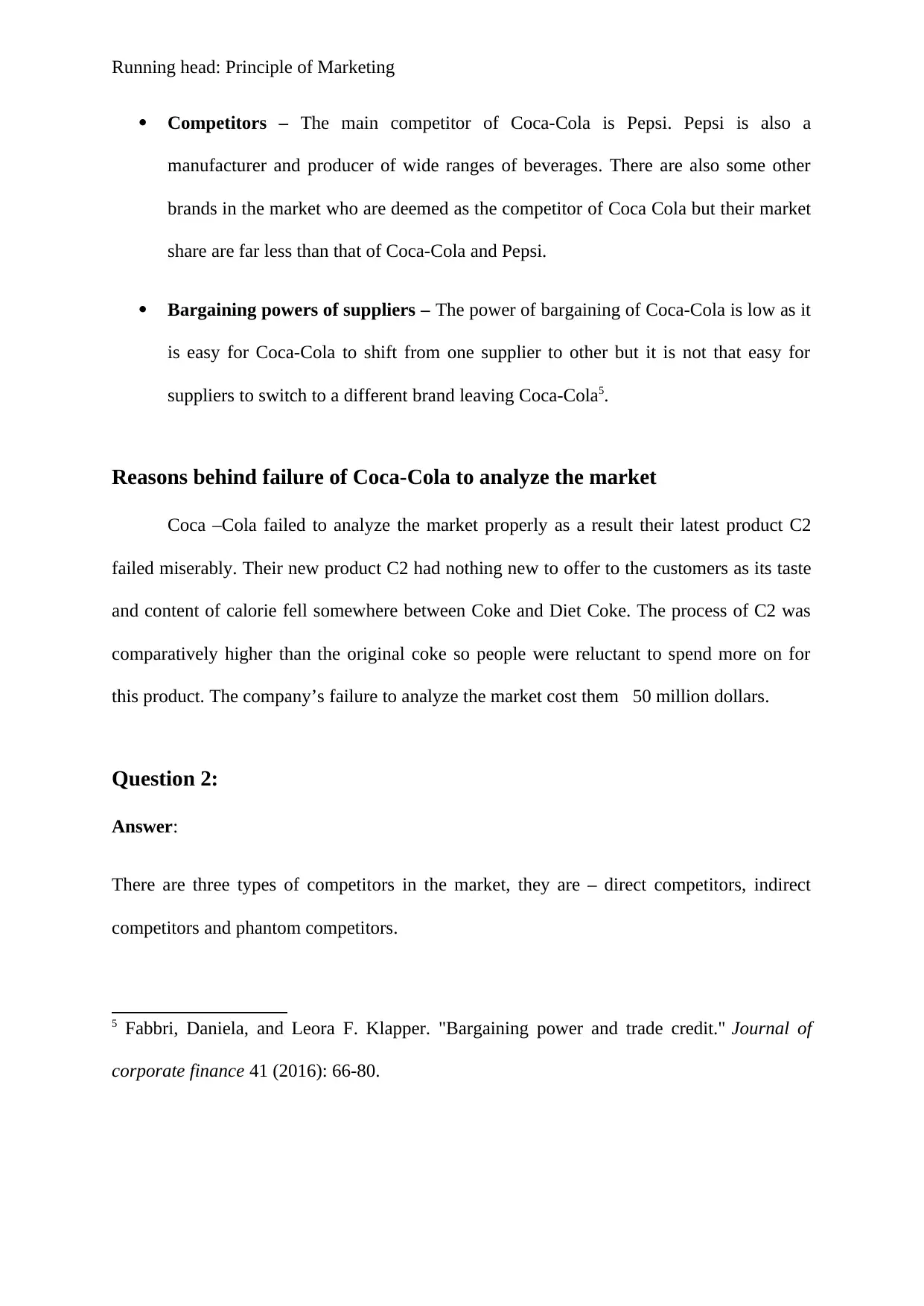
Running head: Principle of Marketing
Competitors – The main competitor of Coca-Cola is Pepsi. Pepsi is also a
manufacturer and producer of wide ranges of beverages. There are also some other
brands in the market who are deemed as the competitor of Coca Cola but their market
share are far less than that of Coca-Cola and Pepsi.
Bargaining powers of suppliers – The power of bargaining of Coca-Cola is low as it
is easy for Coca-Cola to shift from one supplier to other but it is not that easy for
suppliers to switch to a different brand leaving Coca-Cola5.
Reasons behind failure of Coca-Cola to analyze the market
Coca –Cola failed to analyze the market properly as a result their latest product C2
failed miserably. Their new product C2 had nothing new to offer to the customers as its taste
and content of calorie fell somewhere between Coke and Diet Coke. The process of C2 was
comparatively higher than the original coke so people were reluctant to spend more on for
this product. The company’s failure to analyze the market cost them 50 million dollars.
Question 2:
Answer:
There are three types of competitors in the market, they are – direct competitors, indirect
competitors and phantom competitors.
5 Fabbri, Daniela, and Leora F. Klapper. "Bargaining power and trade credit." Journal of
corporate finance 41 (2016): 66-80.
Competitors – The main competitor of Coca-Cola is Pepsi. Pepsi is also a
manufacturer and producer of wide ranges of beverages. There are also some other
brands in the market who are deemed as the competitor of Coca Cola but their market
share are far less than that of Coca-Cola and Pepsi.
Bargaining powers of suppliers – The power of bargaining of Coca-Cola is low as it
is easy for Coca-Cola to shift from one supplier to other but it is not that easy for
suppliers to switch to a different brand leaving Coca-Cola5.
Reasons behind failure of Coca-Cola to analyze the market
Coca –Cola failed to analyze the market properly as a result their latest product C2
failed miserably. Their new product C2 had nothing new to offer to the customers as its taste
and content of calorie fell somewhere between Coke and Diet Coke. The process of C2 was
comparatively higher than the original coke so people were reluctant to spend more on for
this product. The company’s failure to analyze the market cost them 50 million dollars.
Question 2:
Answer:
There are three types of competitors in the market, they are – direct competitors, indirect
competitors and phantom competitors.
5 Fabbri, Daniela, and Leora F. Klapper. "Bargaining power and trade credit." Journal of
corporate finance 41 (2016): 66-80.
Paraphrase This Document
Need a fresh take? Get an instant paraphrase of this document with our AI Paraphraser
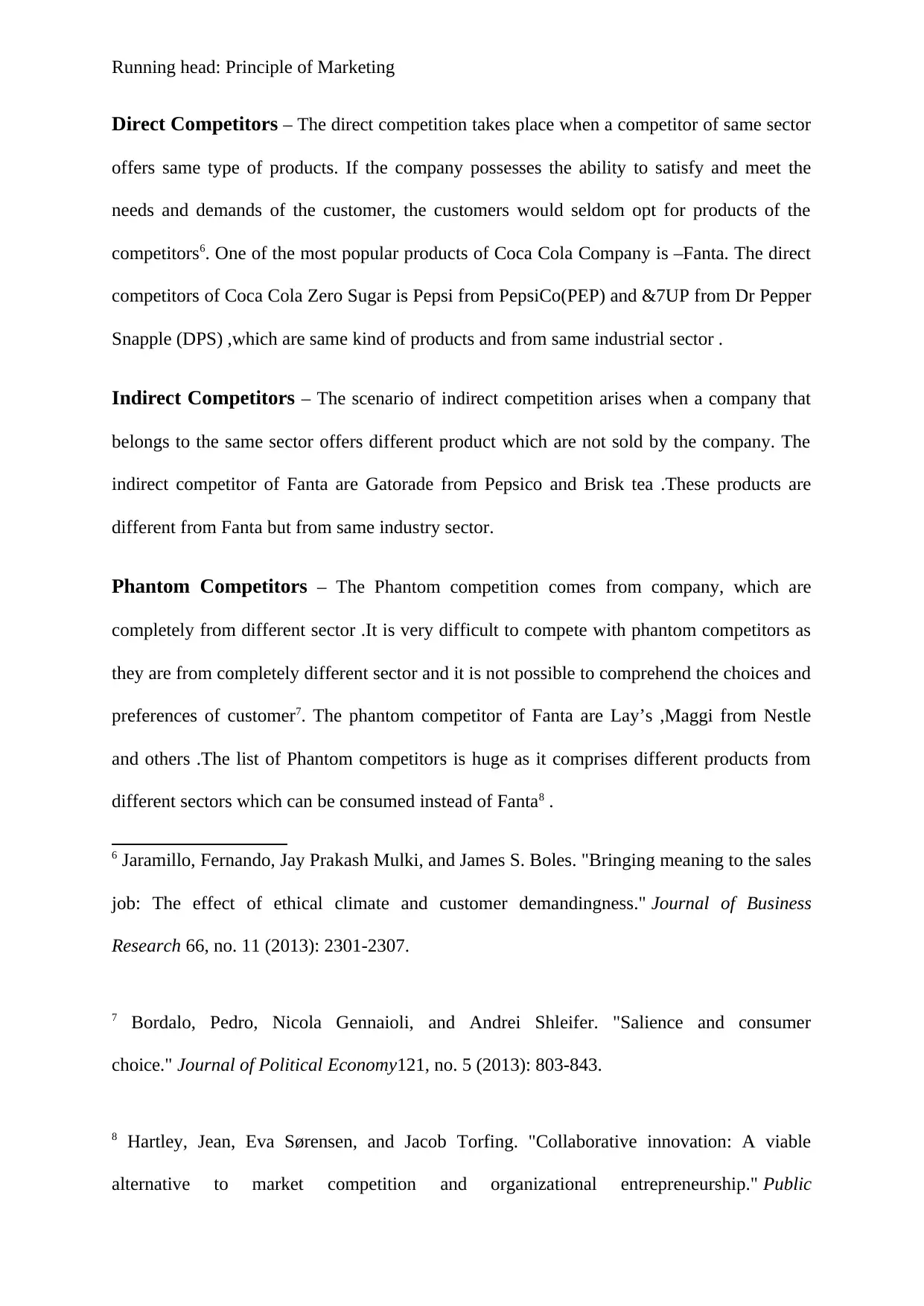
Running head: Principle of Marketing
Direct Competitors – The direct competition takes place when a competitor of same sector
offers same type of products. If the company possesses the ability to satisfy and meet the
needs and demands of the customer, the customers would seldom opt for products of the
competitors6. One of the most popular products of Coca Cola Company is –Fanta. The direct
competitors of Coca Cola Zero Sugar is Pepsi from PepsiCo(PEP) and &7UP from Dr Pepper
Snapple (DPS) ,which are same kind of products and from same industrial sector .
Indirect Competitors – The scenario of indirect competition arises when a company that
belongs to the same sector offers different product which are not sold by the company. The
indirect competitor of Fanta are Gatorade from Pepsico and Brisk tea .These products are
different from Fanta but from same industry sector.
Phantom Competitors – The Phantom competition comes from company, which are
completely from different sector .It is very difficult to compete with phantom competitors as
they are from completely different sector and it is not possible to comprehend the choices and
preferences of customer7. The phantom competitor of Fanta are Lay’s ,Maggi from Nestle
and others .The list of Phantom competitors is huge as it comprises different products from
different sectors which can be consumed instead of Fanta8 .
6 Jaramillo, Fernando, Jay Prakash Mulki, and James S. Boles. "Bringing meaning to the sales
job: The effect of ethical climate and customer demandingness." Journal of Business
Research 66, no. 11 (2013): 2301-2307.
7 Bordalo, Pedro, Nicola Gennaioli, and Andrei Shleifer. "Salience and consumer
choice." Journal of Political Economy121, no. 5 (2013): 803-843.
8 Hartley, Jean, Eva Sørensen, and Jacob Torfing. "Collaborative innovation: A viable
alternative to market competition and organizational entrepreneurship." Public
Direct Competitors – The direct competition takes place when a competitor of same sector
offers same type of products. If the company possesses the ability to satisfy and meet the
needs and demands of the customer, the customers would seldom opt for products of the
competitors6. One of the most popular products of Coca Cola Company is –Fanta. The direct
competitors of Coca Cola Zero Sugar is Pepsi from PepsiCo(PEP) and &7UP from Dr Pepper
Snapple (DPS) ,which are same kind of products and from same industrial sector .
Indirect Competitors – The scenario of indirect competition arises when a company that
belongs to the same sector offers different product which are not sold by the company. The
indirect competitor of Fanta are Gatorade from Pepsico and Brisk tea .These products are
different from Fanta but from same industry sector.
Phantom Competitors – The Phantom competition comes from company, which are
completely from different sector .It is very difficult to compete with phantom competitors as
they are from completely different sector and it is not possible to comprehend the choices and
preferences of customer7. The phantom competitor of Fanta are Lay’s ,Maggi from Nestle
and others .The list of Phantom competitors is huge as it comprises different products from
different sectors which can be consumed instead of Fanta8 .
6 Jaramillo, Fernando, Jay Prakash Mulki, and James S. Boles. "Bringing meaning to the sales
job: The effect of ethical climate and customer demandingness." Journal of Business
Research 66, no. 11 (2013): 2301-2307.
7 Bordalo, Pedro, Nicola Gennaioli, and Andrei Shleifer. "Salience and consumer
choice." Journal of Political Economy121, no. 5 (2013): 803-843.
8 Hartley, Jean, Eva Sørensen, and Jacob Torfing. "Collaborative innovation: A viable
alternative to market competition and organizational entrepreneurship." Public
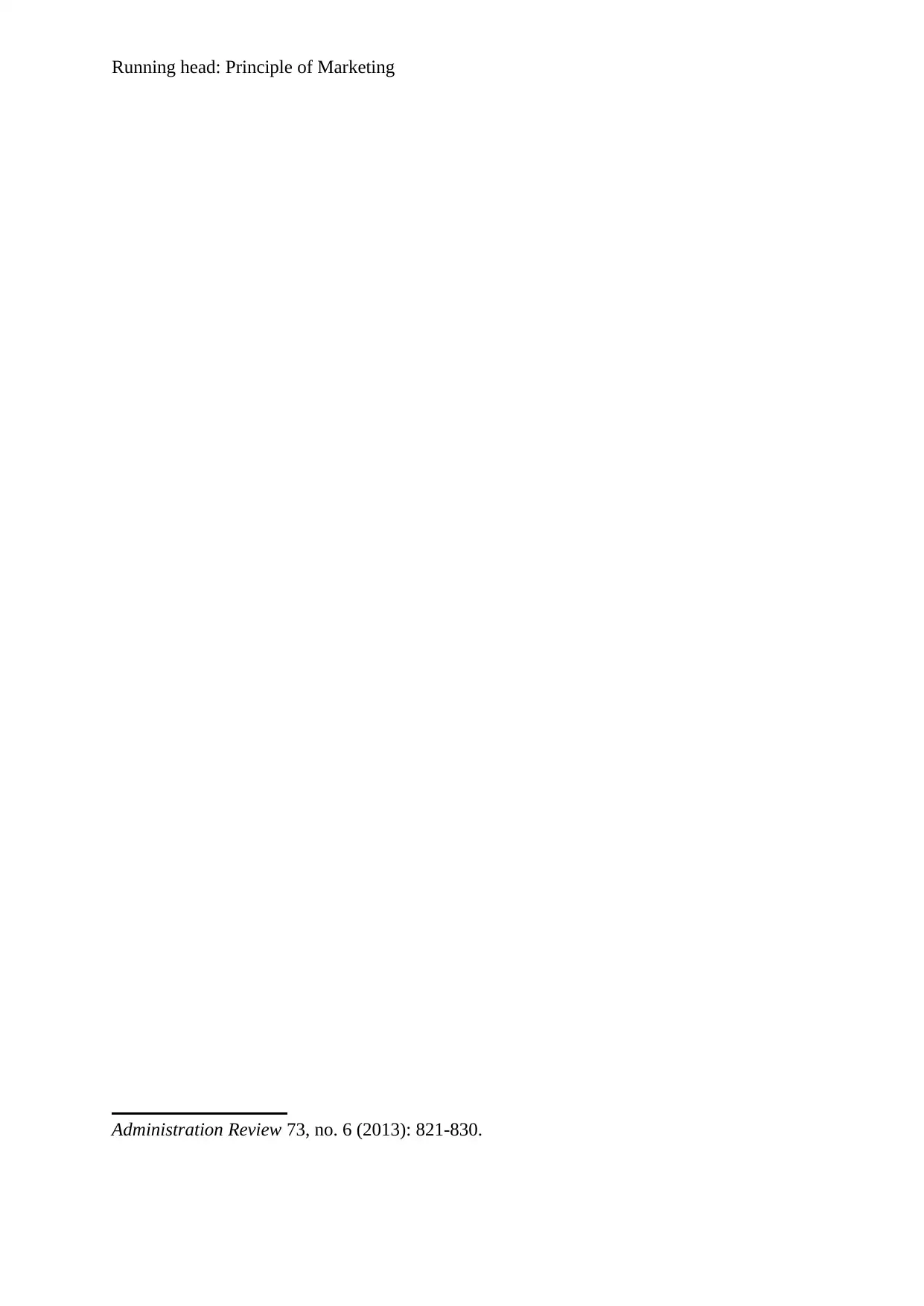
Running head: Principle of Marketing
Administration Review 73, no. 6 (2013): 821-830.
Administration Review 73, no. 6 (2013): 821-830.
⊘ This is a preview!⊘
Do you want full access?
Subscribe today to unlock all pages.

Trusted by 1+ million students worldwide
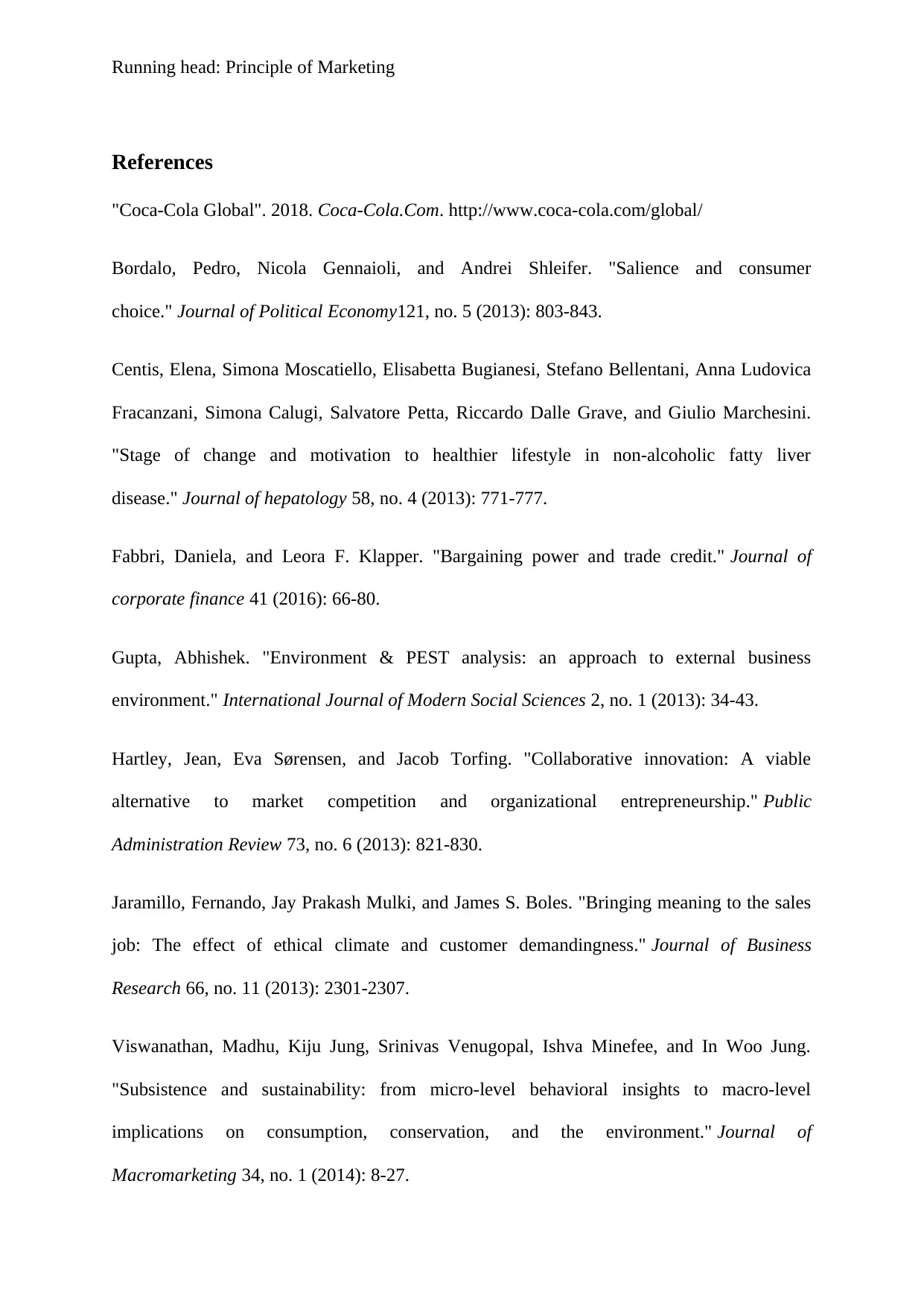
Running head: Principle of Marketing
References
"Coca-Cola Global". 2018. Coca-Cola.Com. http://www.coca-cola.com/global/
Bordalo, Pedro, Nicola Gennaioli, and Andrei Shleifer. "Salience and consumer
choice." Journal of Political Economy121, no. 5 (2013): 803-843.
Centis, Elena, Simona Moscatiello, Elisabetta Bugianesi, Stefano Bellentani, Anna Ludovica
Fracanzani, Simona Calugi, Salvatore Petta, Riccardo Dalle Grave, and Giulio Marchesini.
"Stage of change and motivation to healthier lifestyle in non-alcoholic fatty liver
disease." Journal of hepatology 58, no. 4 (2013): 771-777.
Fabbri, Daniela, and Leora F. Klapper. "Bargaining power and trade credit." Journal of
corporate finance 41 (2016): 66-80.
Gupta, Abhishek. "Environment & PEST analysis: an approach to external business
environment." International Journal of Modern Social Sciences 2, no. 1 (2013): 34-43.
Hartley, Jean, Eva Sørensen, and Jacob Torfing. "Collaborative innovation: A viable
alternative to market competition and organizational entrepreneurship." Public
Administration Review 73, no. 6 (2013): 821-830.
Jaramillo, Fernando, Jay Prakash Mulki, and James S. Boles. "Bringing meaning to the sales
job: The effect of ethical climate and customer demandingness." Journal of Business
Research 66, no. 11 (2013): 2301-2307.
Viswanathan, Madhu, Kiju Jung, Srinivas Venugopal, Ishva Minefee, and In Woo Jung.
"Subsistence and sustainability: from micro-level behavioral insights to macro-level
implications on consumption, conservation, and the environment." Journal of
Macromarketing 34, no. 1 (2014): 8-27.
References
"Coca-Cola Global". 2018. Coca-Cola.Com. http://www.coca-cola.com/global/
Bordalo, Pedro, Nicola Gennaioli, and Andrei Shleifer. "Salience and consumer
choice." Journal of Political Economy121, no. 5 (2013): 803-843.
Centis, Elena, Simona Moscatiello, Elisabetta Bugianesi, Stefano Bellentani, Anna Ludovica
Fracanzani, Simona Calugi, Salvatore Petta, Riccardo Dalle Grave, and Giulio Marchesini.
"Stage of change and motivation to healthier lifestyle in non-alcoholic fatty liver
disease." Journal of hepatology 58, no. 4 (2013): 771-777.
Fabbri, Daniela, and Leora F. Klapper. "Bargaining power and trade credit." Journal of
corporate finance 41 (2016): 66-80.
Gupta, Abhishek. "Environment & PEST analysis: an approach to external business
environment." International Journal of Modern Social Sciences 2, no. 1 (2013): 34-43.
Hartley, Jean, Eva Sørensen, and Jacob Torfing. "Collaborative innovation: A viable
alternative to market competition and organizational entrepreneurship." Public
Administration Review 73, no. 6 (2013): 821-830.
Jaramillo, Fernando, Jay Prakash Mulki, and James S. Boles. "Bringing meaning to the sales
job: The effect of ethical climate and customer demandingness." Journal of Business
Research 66, no. 11 (2013): 2301-2307.
Viswanathan, Madhu, Kiju Jung, Srinivas Venugopal, Ishva Minefee, and In Woo Jung.
"Subsistence and sustainability: from micro-level behavioral insights to macro-level
implications on consumption, conservation, and the environment." Journal of
Macromarketing 34, no. 1 (2014): 8-27.
Paraphrase This Document
Need a fresh take? Get an instant paraphrase of this document with our AI Paraphraser
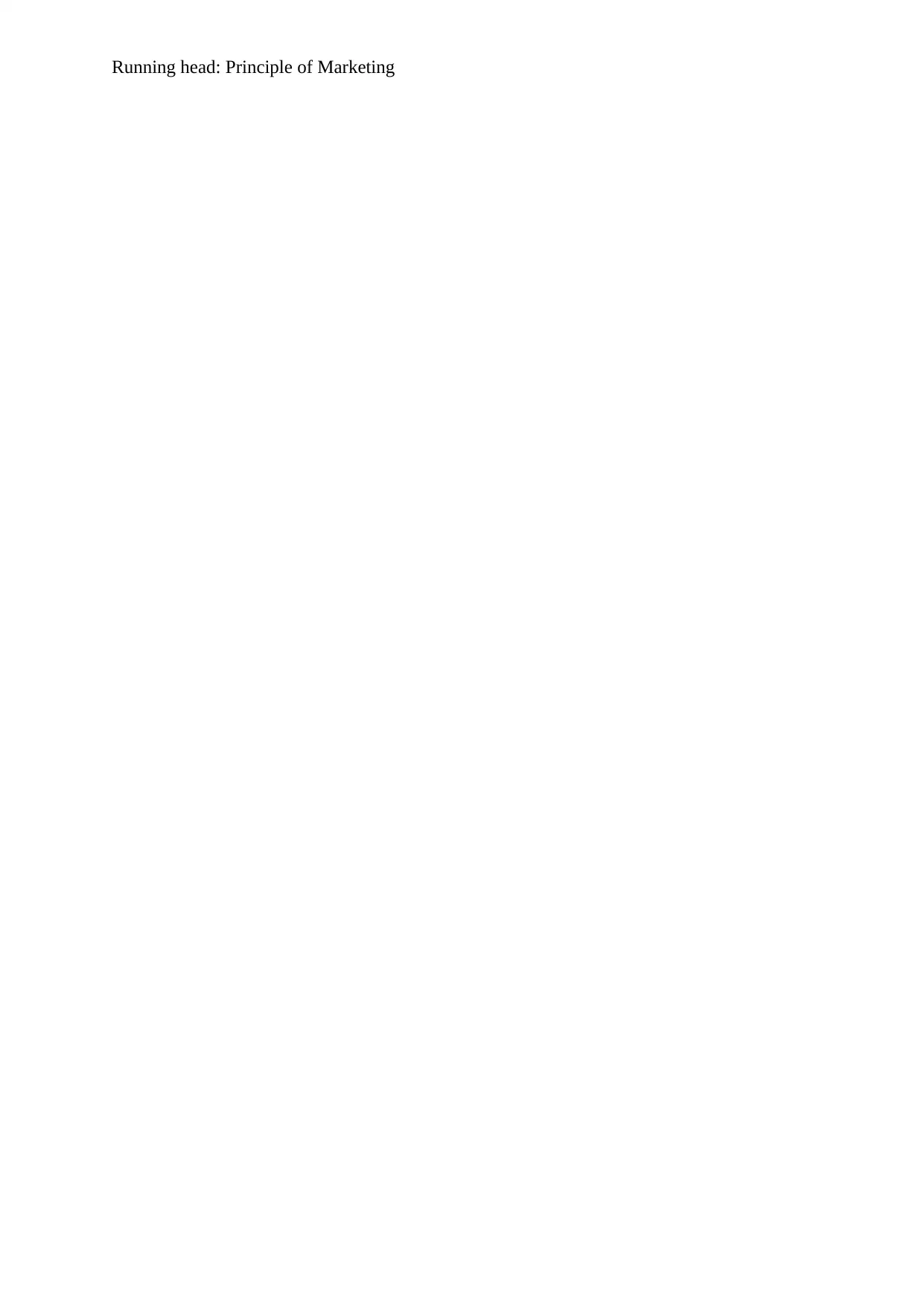
Running head: Principle of Marketing
1 out of 8
Your All-in-One AI-Powered Toolkit for Academic Success.
+13062052269
info@desklib.com
Available 24*7 on WhatsApp / Email
![[object Object]](/_next/static/media/star-bottom.7253800d.svg)
Unlock your academic potential
Copyright © 2020–2025 A2Z Services. All Rights Reserved. Developed and managed by ZUCOL.